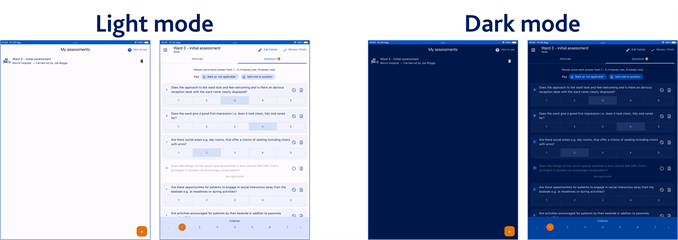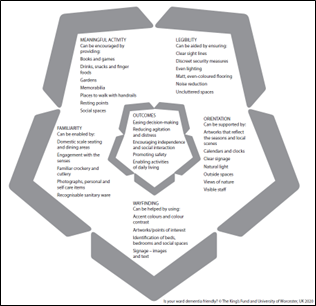Environmental assessment tools
To help as many health and care organisations as possible to develop more supportive design for people with dementia, in 2014 The King’s Fund developed a suite of environmental assessment tools for use across health and care settings a part of their Enhancing the Healing Environment (EHE) programme. With the kind permission of The King’s Fund, the tools were refreshed in 2020 with a tool for gardens added in 2021 by the Association for Dementia Studies, University of Worcester.
Accessing the environmental assessment tools
The suite of environmental assessment tools comprises versions for six different settings. The tools (copyright The King’s Fund and University of Worcester) can be downloaded for free and available as PDFs or as an App. To download PDF versions of the tools, please use the links below.
***The App, which covers all six settings, can be downloaded via this external website - Link to website. ***
The App is available to download in both English and Welsh. The ‘Frequently Asked Questions about the App’ section below will hopefully provide useful information for new users.
For more information about development and use of the tools, please see the relevant sections below.
We are grateful to Betsi Cadwaladr University Health Board for funding the development of the App and making it freely available to encourage the use of the tools across all health and care environments to enable the creation of dementia friendly environments for people affected by dementia and those that care for them.
If you wish to provide any feedback on your experience of using the App, please complete this short survey.
Related resources
Frequently asked questions about the App
We hope that this guide helps you to get started with downloading and using the App – Link to guide
The sections on ‘Using the tools’ and ‘How the results might be used’ may also be of interest, but this section contains a series of short video clips about a variety of topics related to the App. Please note that there is no audio on these videos, but two versions of each video are available with captions in either English or Welsh. The App functionality is the same across different devices so the videos are based on its use on a PC or laptop. However, they do aim to show where the App may look slightly different on a different device:
Depending on the settings on your device, you will see the App in either light or dark mode as shown below. The video clips all use light mode so don't worry if the App looks different on your device.

Environmental Assessment Tool 'Is your garden dementia friendly?' added to the suite of tools
Outdoor spaces assumed greater importance during the pandemic, especially in providing safe spaces for patients, residents and visitors to meet. Although there are a wide variety of gardens and outdoor spaces across the health and care estate, our research and evidence from trials of the tool indicate that the principles of designing gardens for people living with dementia are common across all care sectors. We have therefore developed a generic tool for hospitals, care homes, health centres and specialist and assisted housing.
Following the same format as the other tools in the suite, it is hoped that the gardens assessment tool will also be of use to organisations who are designing gardens and outdoor spaces for people with cognitive impairments or neurodiversity. We are grateful to those who have contributed to the development of the tool and to the University of Worcester for their support.
Background to the development of the tools
In 2014 The King’s Fund developed a suite of dementia friendly environmental assessment tools for use across health and care settings. These were updated by the Association for Dementia Studies, University of Worcester in 2020 to reflect the latest research evidence, best practice and survey responses from those who have used the tools in practice. Each of the sections draws on this evidence to inform a rationale for effecting change in care environments. The rationales recognise that people with dementia often have co-morbidities together with sensory impairments and can experience visuospatial problems.
We are most grateful to The King’s Fund for their permission to update the tools, to the University of Worcester for funding the updates, and to the many people and organisations who kindly gave their time to assist in the development of the 2020 editions.
Why the tools were developed
In response to the Dementia Strategy for England and the Prime Minister’s Challenge on Dementia, The King’s Fund developed a suite of dementia friendly assessment tools for use in care settings. These comprised care homes, housing, health centres, hospitals and wards.
The first assessment tool for the ward environment was developed in collaboration with NHS trusts participating in The King's Fund EHE programme. Since then, over 70 care organisations have been involved in field testing the tools. The tools have been informed by research evidence, best practice and over 300 survey responses from those who have used the tools in practice. Each of the sections draws on this evidence to develop a rationale for effecting change in care environments. These rationales also address the visuospatial problems often associated with dementia.
You can read more about the tools in the article: The Development of Environmental Assessment Tools to support the creation of dementia friendly care environments: Innovative Practice, by Sarah Waller, Abigail Masterson and Simon Evans 2016.
To view the bibliographies from the work carried out in 2014 and 2020 please click here.
Using the tools
The assessment tool can be used by a single individual but involving others who have a different perspective, for example: people with dementia or a family member or accompanying person; clinical, care, managerial, administrative or estates staff; or dementia specialists, can offer valuable opportunities for gaining different views on the care environment and how to improve it. Completing the tool together can also encourage constructive conversations about the philosophy and purpose of care.
The assessment tool comprises seven criteria, each of which contains an evidence-based rationale and a set of questions to prompt discussions. The questions should be completed in full. Walk around the area being assessed and consider each of the questions in turn. Give each question a score out of five, where five indicates that it is ‘met completely’ and one indicates it is ‘not met at all’. You can add any notes including examples of good practice or areas of concern.
The assessment should be undertaken during normal working conditions. However, if this is not possible due to exceptional circumstances, for example control of infection requirements that limit visiting, please mark any appropriate questions as not applicable and note the reason.
Before carrying out the assessment please ensure that all relevant management backing has been secured to build support and commitment to the results. In addition to completing the assessment you may wish to take photographs to support your results which can be used to mark progress and act as a record of improvements. If photographs are taken all relevant organisational and personal permissions need to be obtained.
How the results might be used
Completed assessments can be used individually or shared with others. Within the App, assessments are stored and can be accessed or reviewed at any point. Provided that your device can export data, the results can be exported as a summary (CSV file) or full assessment (PDF) and shared via email.
Scores can be benchmarked against other similar areas in your organisation or more widely to look at comparisons and to highlight particular priorities for improvement. Remember it is often the simple things that can make a big difference such as de-cluttering spaces or providing small seating areas. Similarly, a local photographic competition can produce stunning artworks.
If there are low scores in a particular area, think what action can be taken immediately and what actions need to be addressed with others. If the scores are low overall, together with photographs, this evidence should help inform discussions on the need for environmental improvements with senior management in the organisation.
Cross-organisational use of the results
If you work in an organisation where multiple areas are being assessed, e.g. several care homes or different wards within a hospital, you may find it useful to collate assessments to get an overall organisational perspective. When using the App, this can be done by exporting an assessment and emailing it to a designated person for collation and analysis. A comparison spreadsheet has being developed for each version of the tool to allow you to compile and compare the results from up to ten assessments exported from the App. You can also manually enter results if you use the original paper-based tools. The spreadsheets can be downloaded below.
How others have used their results
Evaluations of the tools indicate that people have already used their results to:
- influence their managers and estates colleagues to support change
- educate staff and help change attitudes
- prioritise areas for improvement
- secure finance from their boards to improve the care environment
- improve signage, flooring and colour schemes as part of maintenance programmes
- redesign dining areas and change crockery.
Overarching design principles
The design principles focus on promoting well-being and independence rather than providing detailed room by room guidance. They have been developed as a result of the EHE programme and bring together best practice in creating more supportive care environments for people with cognitive problems and dementia.
The principles are drawn from a number of sources, including research evidence and the learning gained from changes tested in a range of care environments.
Each of the five sections in the diagram below contains a list of design elements that are known to support, encourage and enable people with dementia in care settings. It is unlikely that all the elements can be addressed at the same time unless a new build or comprehensive refurbishment is being planned. However, many of the principles are simple, can be introduced with very little financial outlay and are known to be helpful in creating a more supportive physical environment for people with dementia and those that care for them.
